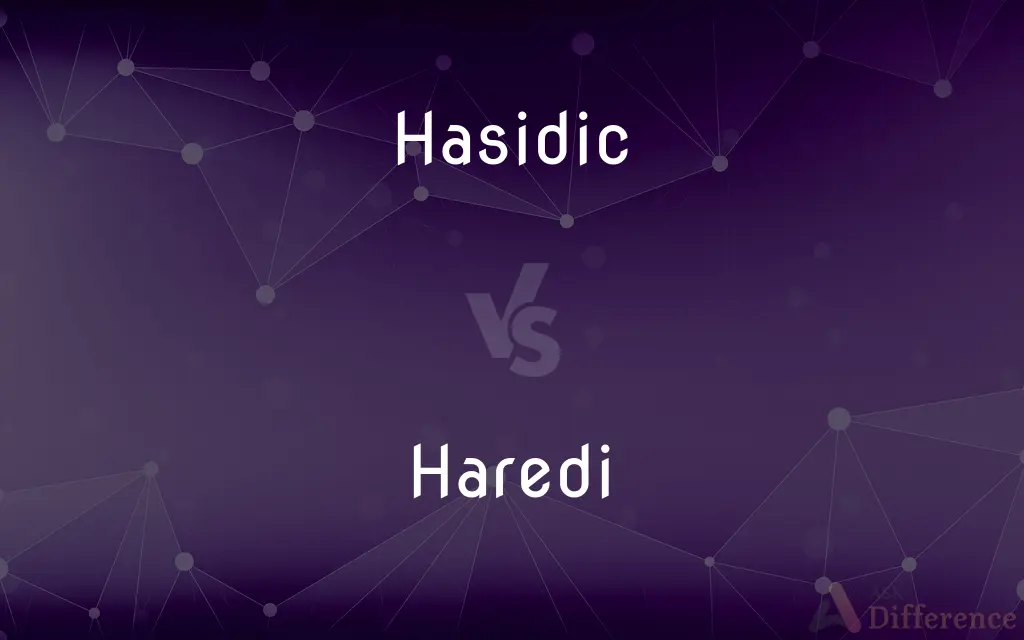Hasidic vs. Haredi — What's the Difference?
Edited by Tayyaba Rehman — By Urooj Arif — Updated on April 19, 2024
Hasidic Judaism is a mystical branch emphasizing joyous spiritual experience, while Haredi Judaism strictly adheres to traditional Jewish law and customs.

Difference Between Hasidic and Haredi
Table of Contents
ADVERTISEMENT
Key Differences
Hasidic Judaism, originating in the 18th century in Eastern Europe, focuses on the personal relationship with God through ecstatic worship and spiritual joy. On the other hand, Haredi Judaism, often referred to as Ultra-Orthodox, prioritizes meticulous adherence to Halacha (Jewish law) and the preservation of traditional religious practices.
Hasidism is known for its dynastic leadership, with communities often led by a Rebbe, a spiritual leader believed to have a close connection to the divine. Whereas Haredi communities typically follow prominent rabbis and decisors of Jewish law but do not center around a singular charismatic leader as in Hasidism.
In Hasidic communities, there is a significant emphasis on the teachings of the founder of Hasidism, the Baal Shem Tov, who taught the importance of worship through joy and humility. While Haredi Judaism places more emphasis on Talmudic scholarship and intellectual study as the primary forms of religious expression.
Hasidic Jews often distinguish themselves with unique garbs such as fur hats (shtreimels) and long coats, symbols of their spiritual devotion and historical tradition. On the other hand, Haredi attire, while also modest and distinct, generally aligns more closely with the dress of their geographic locale, often consisting of black suits and hats without the specific Hasidic distinctions.
The Hasidic approach to outreach and interaction with the broader society can vary widely, with some groups actively engaging in outreach programs to encourage Jewish observance. Meanwhile, many Haredi communities tend to be more insular, focusing on strengthening their own communities and maintaining a distance from secular influences.
ADVERTISEMENT
Comparison Chart
Origins
18th century Eastern Europe
Diverse, ancient roots in Jewish tradition
Emphasis
Mystical, ecstatic worship
Strict adherence to Jewish law
Leadership
Dynastic, led by Rebbes
Led by prominent rabbis
Scholarship Focus
Mystical aspects of Torah
Talmudic and legalistic study
Dress
Distinctive, with cultural garments
More uniform, aligns with locale
Compare with Definitions
Hasidic
A branch of Orthodox Judaism that promotes spirituality and joy in religious practice.
The Hasidic community gathered joyously for the holiday celebration.
Haredi
A form of Orthodox Judaism strictly adhering to traditional Jewish law.
The Haredi community strictly observes the Sabbath.
Hasidic
Characterized by its charismatic leaders known as Rebbes.
The Hasidic Rebbe spoke passionately about the importance of community.
Haredi
Often insular, prioritizing community cohesion.
Haredi neighborhoods are known for their strong sense of community.
Hasidic
Engages in outreach within and outside the Jewish community.
Hasidic volunteers organized a food drive for all residents.
Haredi
Places a high value on Talmudic study.
He spends hours in daily Talmud study, as is customary in Haredi Judaism.
Hasidic
Known for distinctive traditional dress.
He wore a shtreimel as part of his Hasidic attire.
Haredi
Less focused on mystical experiences than Hasidic Jews.
Haredi practices emphasize practical adherence to Jewish laws.
Hasidic
Focuses on the teachings of the Baal Shem Tov.
Hasidic teachings emphasize connecting to God through every action.
Haredi
Adheres to a modest, uniform dress code.
Haredi men typically wear black hats and coats.
Hasidic
A member of a Jewish mystic movement founded in the 18th century in eastern Europe by Baal Shem Tov that reacted against Talmudic learning and maintained that God's presence was in all of one's surroundings and that one should serve God in one's every deed and word.
Haredi
Any of several sects of Orthodox Judaism that reject modern secular culture and many of whom do not recognize the spiritual authority of the modern state of Israel
Hasidic
Of or relating to the Jewish Hasidim or its members or their beliefs and practices
Common Curiosities
Where are the largest Hasidic communities located today?
The largest Hasidic communities are primarily in New York (Brooklyn), Israel, and parts of Europe.
Can women participate in religious leadership in Haredi or Hasidic Judaism?
Women do not traditionally hold formal religious leadership roles in either Haredi or Hasidic Judaism due to Orthodox interpretations of Jewish law.
What is the historical origin of Hasidic Judaism?
Hasidic Judaism began in the 18th century in Eastern Europe, founded by the Baal Shem Tov.
How do Hasidic and Haredi communities handle conflicts with secular laws?
Both communities prioritize religious laws but generally comply with secular laws unless they directly conflict with religious observances.
What is a Rebbe in Hasidic Judaism?
A Rebbe in Hasidic Judaism is a spiritual leader and guide, often considered to have a special connection to the divine.
How is the Sabbath observed differently by Hasidic versus Haredi Jews?
Both observe the Sabbath strictly, but Hasidic Jews might include more singing, dancing, and joyous gatherings as part of their observance.
What role do women play in Hasidic communities?
Women in Hasidic communities primarily manage household duties and children's education, with strong community involvement but limited public religious roles.
How do Hasidic teachings impact everyday life for its followers?
Hasidic teachings emphasize finding holiness in everyday activities, encouraging followers to live with intention and spiritual mindfulness.
What educational systems are typical in Haredi communities?
Haredi communities typically have separate schools focusing on religious studies, with varying emphasis on secular education depending on the community.
How do Hasidic Jews typically engage with non-Jewish communities?
Engagement varies widely; some Hasidic groups actively participate in interfaith activities, while others remain more insular.
How do Haredi and Hasidic Jews view modern technology?
Both groups generally restrict and regulate the use of modern technology to preserve religious values, though practices vary by community.
What are common misconceptions about Haredi Judaism?
Common misconceptions include the belief that Haredi Jews are completely cut off from the modern world or that they all think and behave identically.
What languages are commonly spoken in Haredi communities?
Yiddish and Hebrew are widely spoken in Haredi communities, with the choice often depending on the community's geographic and cultural origins.
What are the key religious texts studied in Hasidic Judaism?
Hasidic Jews study the Torah, Talmud, and Hasidic texts like the Tanya that focus on mystical and ethical teachings.
What distinguishes Haredi Jews in Israel from those in other countries?
Haredi Jews in Israel often engage more directly in political processes and have a significant influence on national religious policies, differing from their often more insular counterparts abroad.
Share Your Discovery

Previous Comparison
Bibliography vs. Webography
Next Comparison
Destroyer vs. FrigateAuthor Spotlight
Written by
Urooj ArifUrooj is a skilled content writer at Ask Difference, known for her exceptional ability to simplify complex topics into engaging and informative content. With a passion for research and a flair for clear, concise writing, she consistently delivers articles that resonate with our diverse audience.
Edited by
Tayyaba RehmanTayyaba Rehman is a distinguished writer, currently serving as a primary contributor to askdifference.com. As a researcher in semantics and etymology, Tayyaba's passion for the complexity of languages and their distinctions has found a perfect home on the platform. Tayyaba delves into the intricacies of language, distinguishing between commonly confused words and phrases, thereby providing clarity for readers worldwide.













































